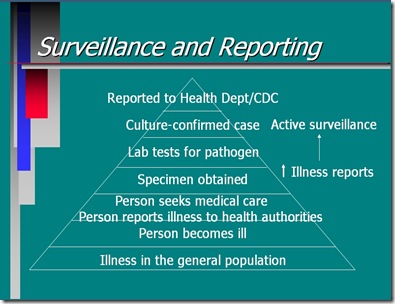Credit CDC
# 8517
We are now two years into the MERS outbreak on the Arabian Peninsula, with roughly 350 human infections announced to date. Of those, nearly 30% have been reported over the past month. A spike in case reports that has many scientists wondering if the virus is better adapting to human hosts (see Osterholm On NPR Shots).
Given limited (and sometimes, totally absent) surveillance for the virus in the Middle East and the wide variability of illness it produces in humans (from asymptomatic to severe, or even fatal), the actual number of infections is undoubtedly much higher.
As with any disease, we usually only see the tip of the pyramid, and must rely on various tools (like seroprevalence studies) to estimate the true burden. Tools that have yet to be well utilized in this MERS outbreak.
Although no surveillance system can expect to capture all of the cases, keeping epidemiological line listings remains an important tool. It can show trends, geospatial clustering, epidemiological links between cases, and can suggest the rate at which an infection is spreading.
Even under the best of conditions maintaining a line listing is a difficult job, but in the case of MERS, far too often the case data announced by the Ministries of Health in the region have either been delayed or have not contained the kind of information (onset dates, previous contacts, date of lab confirmation, etc.) that would be particularly useful.
Compared to the H7N9 information we’ve seen coming from the Chinese Authorities, the quality of data on MERS cases has been very uneven and disappointing.
Despite the difficulties involved, Sharon Sanders and the newshounds on FluTrackers have been maintaining an extensive 2012-2014 Case List of MoH/WHO Novel Coronavirus nCoV Announced Cases for the past 15 months. Case are linked to the MOH or WHO announcements, and are updated (when possible) with outcomes. Cases are also grouped by `cluster’ and by country.
Almost from the beginning, however, it was apparent that there were `gaps’ in the reporting of cases out of the Middle East, and so Sharon posted the following announcement at the top of the list nearly a year ago.
As the number of cases has grown rapidly over the past month, we’ve seen some `blind’ announcements coming from various MOH’s, where batches of `new cases’ are announced without any identifying details (age, gender, location, etc.).
When cases are eventually reported to the World Health Organization and posted on their Global Alert & Response webpage, there is no way to link those cases with earlier `blind’ reports.
Although the number of these `unable to match’ cases is small right now, keeping any sort of `count’ of cases grows more difficult with each passing day. `Creeping errors’ are inevitable, and so today Sharon Sanders (who deserves the `Dogged Determination Award’ for curating this list for well over a year) made the following announcement on her list.
PLEASE NOTE: Due to apparent redundant case reporting, we are no longer tracking case totals. April 23, 2014
FluTrackers will continue to accrue and post cases, and that information will continue to be incredibly useful to bloggers, journalists, and researchers. But there are limits as to what can be done when data is released haphazardly, or without adequate detail, by health ministries.
As to whether this signals a new, more serious `phase’ in the MERS outbreak . . . well, it is possible.
Unfortunately, the outside world isn’t being given enough information to make that determination.

